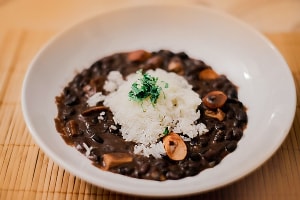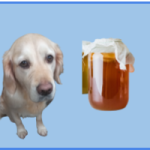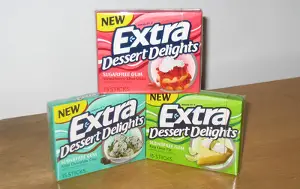
Beans and rice is a very nutritious mix to add to your dog’s diet every now and then.
What! You mean my dogs can’t live off beans and rice?!
As fantastic as beans and rice are (and they are said to be a complete protein) they do not contain all the nutrients which are required by our dogs to survive and thrive!
And feeding your dogs beans does require some careful handling.
Dried beans need to be soaked and then cooked to make sure that harmful toxins are destroyed.
There is nothing wrong with using canned beans either.
As long as you are buying cans that don’t have any added salt- otherwise you will be accidentally feeding your dog colossal amounts of salt which is unnecessary and dangerous.
The history of beans and rice
Beans and rice are an incredibly popular meal in South America.
Eaten by the poor and the rich alike, in places like Brazil the combination is eaten everyday.
It is thought that it was the Spanish and Portuguese who first brought it to the continent.
But how exactly can it help our dogs?
Let’s find out, shall we?
What is the nutrition in beans?
In order to do a short nutritional analysis, I need to choose three types of bean to focus on- pinto, red kidney beans and black beans.
If you are used to using another type of bean with your rice, then please forgive me.
What nutrients do these beans contain?
| 100 g serving | Pinto | Red Kidney | Black |
| Calories | 187 | 135 | 178 |
| Fat | 7.1% | 6.8% | 5.9% |
| Dietary Fibre | 7.4% | 8% | 9.8% |
| Sugar | 1.6 % | 3.1% | .3% |
| Protein | 7.4% | 8.7% | 8.5% |
| Vitamin B1 | .079 mg | .168 mg | .188 mg |
| Vitamin B6 | .206 mg | .127 mg | .074 |
| Phosphorus | 148 mg | 177 mg | 153 mg |
| Copper | .260 mg | .245 mg | .272 mg |
So there you have it.
Broadly what we see with these three sorts of beans is that they provide a low calorie, high fat, high fibre, high carbohydrate and medium protein food source.
These beans are a great source of B vitamins- pinto contains lots of B6 (which is perfect for creating red blood cells) and kidney beans and black beans are packed with vitamin B1 (excellent for changing carbs into energy.)
Black beans also contain quite high levels of vitamin E whereas pinto and red kidney beans don’t.
Vitamin E protects a dog’s cells from harmful free radicals which are a by-product as food is converted into energy.
In terms of minerals, copper is the big hitter in these beans with .272 mg in copper, .260 mg in pinto .245 mg in red kidney beans.
Copper has a few functions in your dog’s body.
From helping keep their bones strong and healthy to helping their metabolism function properly.
All the beans have a great source of phosphorus which help keep the bones and teeth healthy within your dog.
Having found out why pinto, red kidney and black beans are so fantastic, I shall now compare white and brown rice.
So which should be your bean of choice when it comes to your dog?
For me, it would have to be the humble kidney bean and for no other reason that availability and price.
I know that week in, week out I could reliably source kidney beans from my local grocery store- whereas I’m not too sure that I could so easily get hold of pinto or blck beans.
How about you?
Having found out why pinto, red kidney and black beans are so fantastic, I shall now compare white and brown rice.
What is the nutrition in rice?
What rice offers in terms of nutrition is a low fat, high carb food source.
| 100 g serving | Cooked white rice | Cooked brown rice |
| Calories | 129 | 122 |
| Fat | .3% | 1% |
| Carbohydrate | 28 % | 25% |
| Protein | 2.7% | 2.7% |
| Vitamin B1 | .162 mg | .177 mg |
| Vitamin B6 | .092 mg | .122 mg |
| Phosphorus | 43 mg | 102 mg |
| Copper | .069 mg | .105 mg |
| Magnesium | 12 mg | 39 mg |
| Selenium | 7.5 mcg | 5.8 mcg |
Brown rice seems to offer more when it comes to vitamins and minerals and has higher concentrations of all the main ones apart from selenium, which is a little known mineral.
By all accounts it helps with metabolism and it also supports the proper functioning of the thyroid gland.
We have already heard about the important role that B vitamins, phosphorus and copper play when it comes to our dog’s health.
But that just leaves little old magnesium.
Well less of the little and old as it helps to make DNA and helps the brain communicate with other body parts.
Having analysed beans and rice separately, I now want to look at what makes them such a magical combination.
Beans and rice- a complete protein
When rice and beans are eaten together, they are known as a complete protein.
A complete protein is very important nutritionally because it means that together beans and rice have all the essential amino acids in them.
Amino acids such as Lysine, Leucine and Valine.
And complete protein is a phrase used with humans in mind.
But dogs need most of these amino acids as well.
Can I just feed my dog on beans and rice?
Although together beans and rice seem like an unstoppable nutrition double act, the sad fact is that dogs need a lot more nutrients than these two foods can provide.
Dogs, like humans, need a very specific balance of proteins, fats, carbohydrates, minerals and vitamins.
Their very particular needs are spelled out on page four of this document.
Put simply, rice and beans don’t tick all of those boxes.
Neither does a homemade diet of rice and chicken.
And you would need to be a cross between a magician and a genius to create that mix at home.
Kibble or canned food which is labelled as “complete” has the right mix of all the nutrients, which is why it is the safest and wisest choice for dog owners.
How should I use beans and rice with my dog?
I think that the best way of using rice and beans with your dog is to feed it to them instead of one of their main meals every couple of weeks.
And if you are used to eating your rice and beans with lots of seasoning and spices, don’t use those with your dog.
Just cook the beans and rice in plain water.
That way, your dog gets a little bit of variety in their diet and a big boost of proteins without messing up the nutritional balance from their dry or wet food diet.
And as their owner, you will get to experience those beautiful aromas which come from feeding our dog beans!!
What beans are toxic to dogs?
There are quite a few beans that your dog shouldn’t eat.
The mysterious case of fava (broad beans)
The fava bean and the advice around it confuses me.
It has long been thought that your dog shouldn’t eat fava or broad beans because of a chemical in them called PHA (phytohemagglutinin.)
By all accounts this compound is highly toxic because it can cause vomiting and diarrhea from just eating a few raw beans.
But PHA can be found in much higher levels in red kidney beans and so I don’t quite understand why it is flagged as a toxin for dogs in broad beans but not red kidney beans.
After all, neither of them should be fed to a dog raw.
Another interesting thing about fava beans is that there has been some research carried out where it has been successfully added into dog food.
The fava beans used in the food were “dehulled” but all dogs completed the trial and no ill effects were noted.
What other beans should your dog not eat?
In creating this list I feel like I might be stating the obvious but here goes.
Baked beans shouldn’t be fed to dogs because of all the additives and the high levels of salt and sugar used.
Coffee beans are highly toxic to your dog because dogs and caffeine don’t mix well.
Humans get a temporary high from caffeine but for dogs the effects are more extreme and they can last longer.
Refried beans are also best avoided, like all fried foods and particularly if they contain any form of garlic, which is a known toxin with some dogs.
Many of us that eat a lot of beans tend to keep tins of beans because they are so much more convenient to use than dried beans.
And there is nothing wrong with using canned beans with your dog- so long as they don’t have any salt added.






